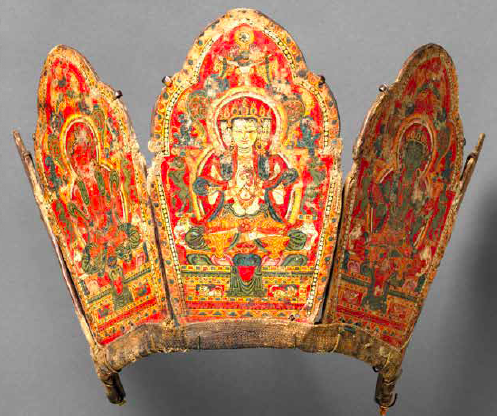Take a fascinating journey into the world of Buddhism with our latest release, Buddhism: A Journey Through Art by RM Woodward. An aesthetic exploration of the practice, ritual, meditation, and devotion of the varied Buddhist tradition, this visually stunning book chronicles the fascinating history of Buddhist art spanning over 2000 years. Take a look at some of the beautiful artwork from the book.
Chakrasamvara and Vajravarahi

Chakrasamvara (‘Circle of bliss’) is very prominent in Tibetan Buddhist traditions and one of the most popular deities in Tantric Buddhism.The deity is depicted here locked in an electrifying embrace with his bright red consort Vajravarahi, who holds a curved knife in her hand, a ritual object used symbolically to destroy forces that stand in the way of enlightenment. Considered one of the finest representations, Chakrasamvara here holds a vajra in his right hand and a bell in his left. The vajra and bell, representing method and wisdom, are the most important ritual objects of Tibetan Buddhism. The garland of severed heads Chakrasamvara is wearing around his neck is something Vajrayana Buddhism adopted from Hindu iconography.
Standing Buddha

This beautifully sculpted figure of the Buddha Sakyamuni (the historical Buddha) was sensitively chiselled in schist, a stone typical of Gandharan sculpture. This style of artefact was found in large numbers around what would have been consecrated regions within Gandhara and so may have been intended for monastic worship. The topknot of the Buddha served as a reminder that the Buddha was born into the warrior caste. The nimbus surrounding the Buddha’s head is akin to halos found in ancient art traversing many religions. The nimbus was absorbed into Buddhist iconography by the third century and believed to have been brought to the East from the Greeks.
Gilt Figure of Marichi

Marichi (from Sanskrit ‘beam of light’) is a Buddhist Dawn Goddess and celestial warrior. Her Tibetan name, Oser Chenma, literally translates to ‘Great Light Goddess’. She is venerated as a heavenly warrior and guardian who removes doubt and fear. Marichi is a Buddhist and Taoist deity in China. She is venerated by Chinese Buddhists as the defender of all nations from the devastation of war. She has three eyes in each of her four faces and four arms on each side. The goddess is depicted with multiple faces, one of which is a boar. This boar face represents the goddess’ aggressive and protective attributes. Her peaceful middle face contrasts with her other angry face, indicating her gentle yet vigilant nature. Her two clasped hands hold a Sun, Moon, bell, and golden seal. The Sun represents the feminine aspect of wisdom and the Moon the male aspect of compassion.
Buddha, Bodhisattvas and Taoist Scholars

This image combines Buddhist and Daoist art from late Joseon. Chilseong Buddha, the deified North Star in the painting, was known for his ability to demolish misfortunes. Seven Buddhas, representing the Great Dipper’s Seven Stars, surround the central Buddha, who is flanked by Chandraprabha (Moonlight) and Suryaprabha (Sunlight). Below are the Daoist equivalents to the Seven Buddhas. In Korean Shamanic culture, the Big Dipper, also known as Ursa Major, is revered and despite being regarded as a unique deity, the subject is most usually represented as a seated Buddha supported by other Buddhist deities and followers. In Taoism, Chilseong, an altered form of Buddha Yaksayeorae, is revered in Buddhist monasteries and considered to keep an eye on people’s fortune. The worship of Chilseong developed across the country, mixing folk religion with Buddhism and Taoism.
Ritual Crown with the Five Transcendent Buddhas

This headpiece would have been worn by a Buddhist monk during certain rituals or ceremonial practices within Esoteric Buddhism. Each Tathagata Buddha is represented in one of the five registers with the colour denoting the Buddha’s form (from left to right) we find: Ratnasambhava (yellow), Amitabha (red), Vairochana (white), Amoghasiddhi (green), and Akshobhya (blue).
Attendant Bodhisattva

This beautifully carved sculpture has many elements that stand out, especially the incredible lifelike features of the face. The lips and nose are exceptionally realistic whilst the eyes and eyebrows have a slightly more stylized quality. The hair and torso were deliberately simplified by the sculptor so that the eye is drawn immediately and intentionally to the figure’s face. The brows are furrowed in deep contemplation and contrasted by an amicable countenance of soft facial features. This sculpture of a bodhisattva attendant was most likely part of a massive triptych that featured a Buddha in the centre.
Conquering the Demons
(Shaka Gōma-zu)

Kawanabe Kyōsai (1831–89) painted with much wit, vigour, and personality – he is known as one of Japan’s most influential artists with particular significance to manga. This finely executed painting of ink and pigments illustrates the Buddha’s journey to enlightenment under the bodhi tree. The fire-breathing dragon represents Mara, who embodies the forces that oppose enlightenment.
Birth of the Buddha

The woodblock print has long played an iconic role in the history of Japanese art. This print of the birth of Buddha was created during the Edo period, arguably the greatest era for woodblock printing. The central figure here is an infant Buddha who stands upon a lotus flower, his mother (Maha Maya) is seen reaching up to grasp a tree branch. According to Buddhist legend, Maha Maya travelled to the Lumbini grove outside of Kapilavastu where the newborn Buddha miraculously emerged from beneath her right arm as she stood upright and grasped the branch of a sal tree. A dream Maha Maya had before conception expressed this good omen, in which a white elephant with six tusks passed through her right side – this was believed to imply a prophecy that she would give birth to either a global ruler or a spiritual leader. Seven days after his birth, Maha Maya died and was reborn in the Tavatimsa Heaven.

